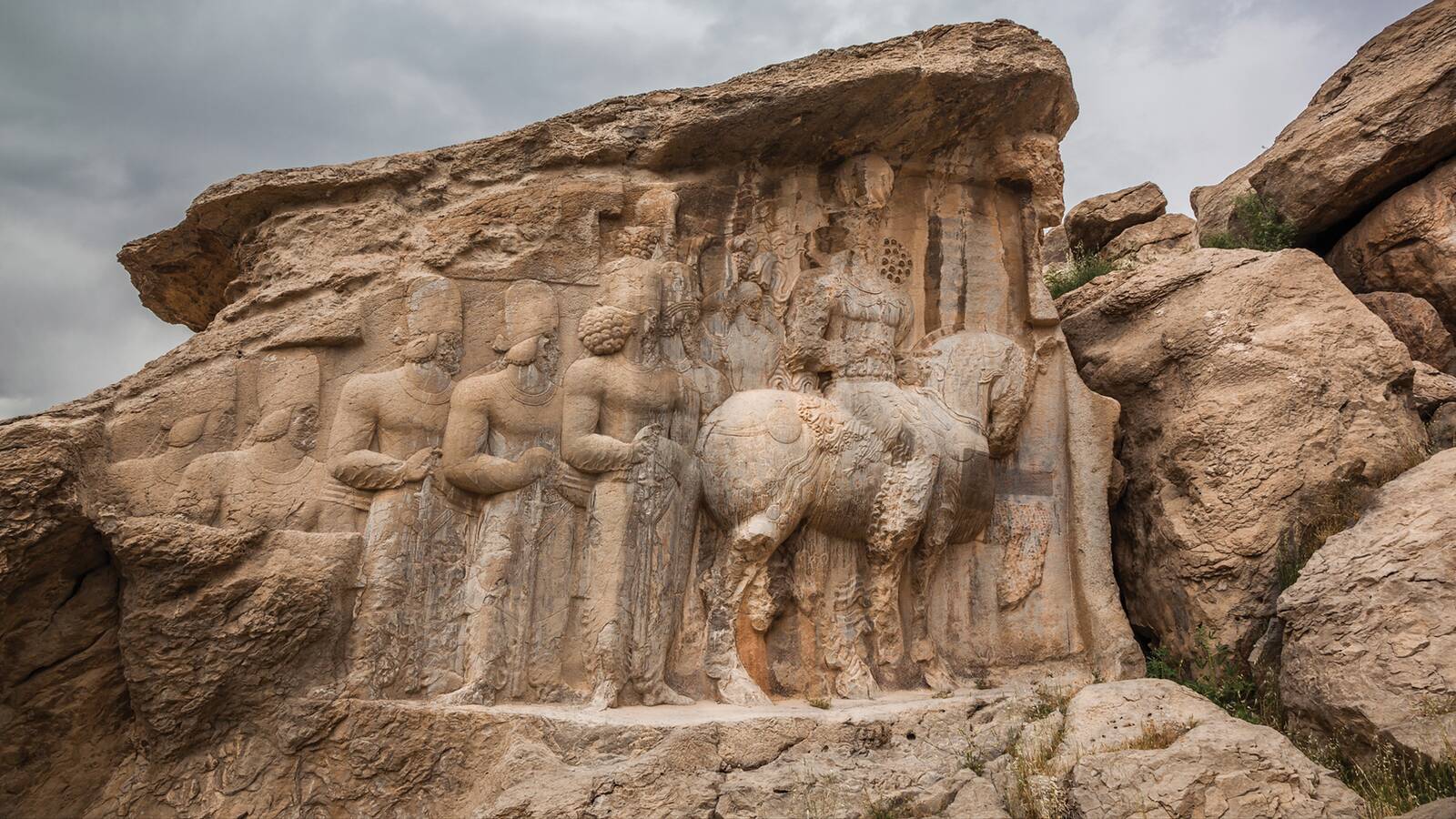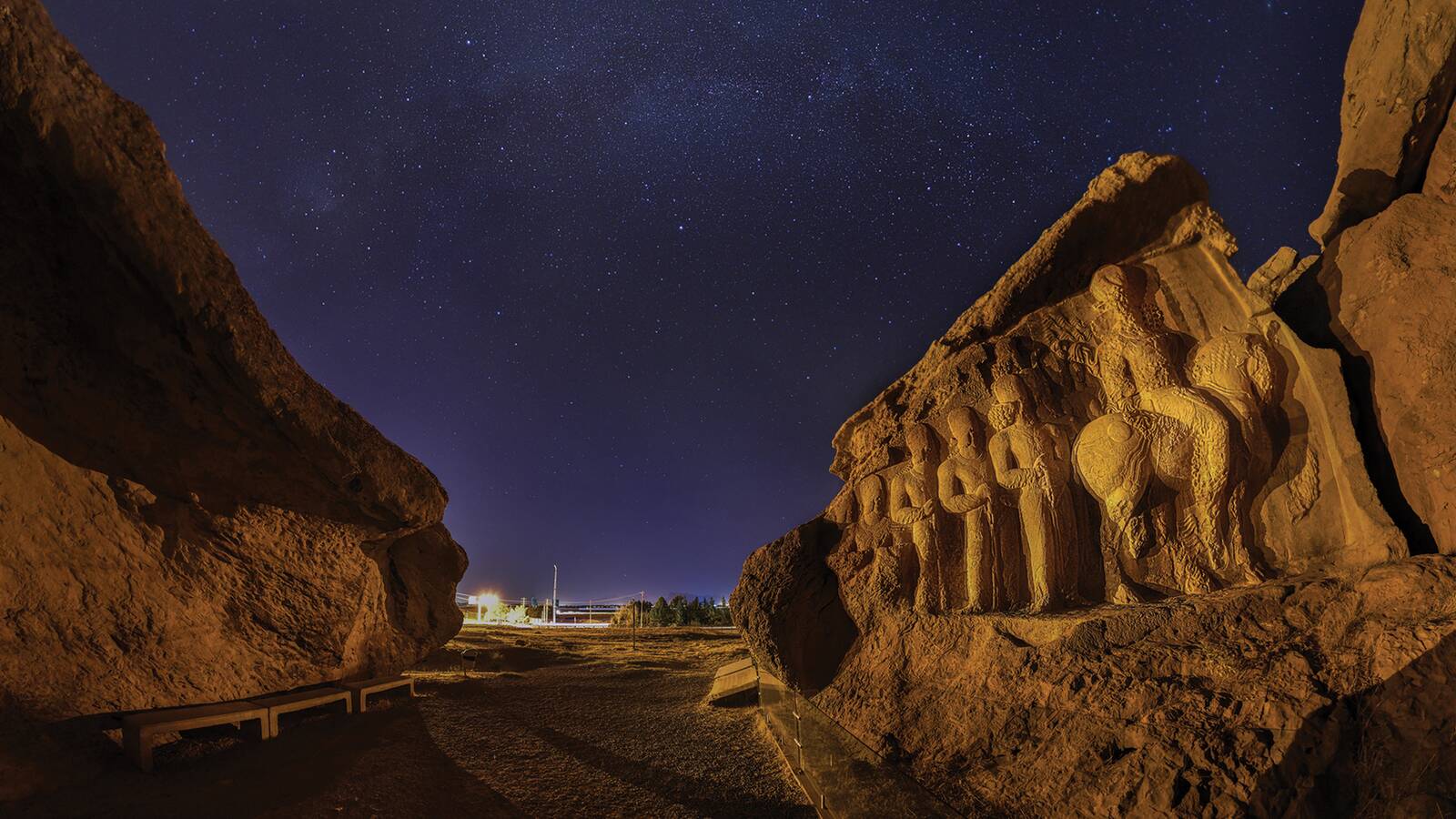Introduction of Naqsh-e Rajab Archaeological Site
The reputation of Naqsh-e Rajab Archaeological Site may not be as much as Pasargadae or Persepolis, but its value equals that of other historical monuments in Shiraz. It seems that Naqsh-e Rajab is not the name of an ancient person, but probably the name of a person who had a tea house nearby.

History of Naqsh-e Rajab Archaeological Site
The stone carvings of Naqsh-e Rajab Archaeological Site dates back to the beginning of the Sassanid era, with Sasanian kings each narrating their story as a street theater, directing three plays of Sassanid rule in three different periods. They were interested in orthography, thus left a museum of stone carvings in the Naqsh-e Rajab and Naqsh-e Rustam, embellished with four reliefs on the stone and two inscriptions.
Naqsh-e Rajab Architectural Details
Rock cuts and reliefs
At the foot of the mountain, you will see the first commanding carving of Ardashir Papakan‘s coronation, the founder of the Sassanids in Naqsh-e Rajab Archaeological Site, engraved stone, proclaiming his kingdom. In such an eye-catching scene, you see Ardashir raising his left hand as a sign of respect, taking the royal ring with the right hand of the high priest of the time. The cleric has an object in his left hand, some call it a sacred plant, and others name it a royal cane. The Fan-bearer and one of the courtiers stand beside the King.
Inscriptions
There are also two engraved children, one of which is a princess, and the other could be a symbol of Ahuramazda, with two courtiers beside them; at the end, you see someone showing the sculptor to the others. The second remarkable carving depicts the coronation of Shapur I, Ardashir Papakan’s son, who is mounted on horseback, receiving a royal crown or ring; the royal ring is being given to the high priest sitting on the horse.
In the northern part of the Naqsh-e Rajab Archaeological Site, there is a catchy figure showing Shapur with nine Sassanian elders, one of them is Hormuz I, known from the succession mark on his hat, and also engraved on Shapur’s horse. The carvings are on an inscription in the Pahlavi language, one and a half meters high from the ground level. Another noticeable engraving of Kartir is the Zoroastrian priest, which is why he became known as Kartir. He was a powerful and influential priest who held office during the reign of six Sassanid kings, from the time of Ardashir Babakan to Narseh, the seventh Sasanian King. The description that remains in historical writings of Kartir is his zeal for Zoroastrianism and this remarkable engraving; you see Kartir without a beard and hat, so the inscription in the orthography of Pahlavi language introduces him. The engraving illustrates the power of the Zoroastrian mob in the Sassanid system as only the Sassanid kings could have had a prominent inscription or role in such a place.
Finally, we can say that Naqsh-e Rajab is an identifying motif of the Sassanid princes, and you will be closely acquainted with the beliefs of the powerful Sassanian government, its glory, and grandeur in the heart of the mountain.

Location of Naqsh-e Rajab Historical Site
Naqsh-e Rajab Archaeological Site, located three kilometers north of Persepolis, is a prominent part of the mountain slope where was on the route of Persepolis to the city of Istakhr in the Sassanid period. The place was one of the largest ancient cities of Persia, the birthplace of Ardashir and Shapur, located 13 km from Marvdasht and 56 km from Shiraz, as well as in Naqsh-e Rajab.
Where to eat near Naqsh-e Rajab
- Persepolis Persian Restaurant
Persepolis Persian Restaurant is on the private road of Persepolis. The restaurant is a complete traditional ambience, suitable for family gatherings, with an exquisite atmosphere. - Sufi Restaurant
Sufi Restaurant is one of the oldest restaurants in Shiraz, which serves a complete menu of Persian and French fare in a lovely traditional atmosphere, decorated in the Zandieh era’s style. Some say that the best Kalam Polo Shirazi (Cabbage and rice – Shiraz’s traditional food) is available in this restaurant. - Sharze Restaurant
Sharze is the oldest restaurant in Shiraz with a unique traditional interior design, where you can enjoy delicious food with hot and fresh bread baked by the chef. You can also enjoy live music there.
Where to stay near Naqsh-e Rajab
- Parsian 4* Hotel
Parsian 4* Hotel is another member of Parsian Hotels Group, located in the city centre with amenities and desirable services and is a good choice for tourists. - Darbary Hotel
The Darbary Hotel complex is in the historical and cultural context of Shiraz. One of the significant advantages of such a 3* international hotel is the modern, up-to-date facilities in a traditional environment. - Mah Monir Residence
Mah Monir Traditional Residence, the 120-year-old residence that dates back to the late Qajar and early Pahlavi eras, is considered an economy hotel in Shiraz. - Persepolis Tourism Complex
Persepolis Tourism Complex is one of the hotels with a history of providing tourism services; it is at 8 km of Marvdasht-Persepolis road 72 km from Shiraz city. - Apadana Hotel
Apadana Hotel in Persepolis is a stunning building belonging to the second Pahlavi era, located 100 meters from the magnificent Persepolis site. The hotel is in the middle of a garden that has provided a pleasant atmosphere for visitors. - Chamran Grand Hotel
Shiraz Chamran Hotel, or Chamran Grand, is a 5* luxury hotel at the highest point of the cultural capital of Persia, Shiraz. Overlooking Qasr al-Dasht, Shiraz Chamran Hotel gives you a unique view of Eram Garden and Hafez Tomb. Chamran Tourist Hotel complies with international quality standards, a variety of Persian, traditional, and Italian restaurants, and a coffee shop with live music, creating enjoyable memories of staying in a calm and friendly environment. - Zandieh 5* Hotel
The 5*r Zandieh Hotel in Shiraz is in the Zandieh complex. The hotel is near the historical and cultural spots of the city, such as the Karim Khan Zand complex and Pars Museum. The traditional Persian bathhouse or Hammam with impressive architecture is one of the most spectacular services that the hotel guests can enjoy. - Aghamir Cottage Pasargad
Aghamir Ecological Resort in Pasargad, Shiraz, with a history of 100 years, is located in the historical context of Saadat Shahr. The residence is a local house embracing brick walls and historical architecture belonging to the past. It is also active in promoting cosmic tourism (Astro-tourism). By staying at Aghamir Cottage Hotel, in addition to experiencing a simple life in a local dwelling, you can also benefit from the various programs. Pasargadae and the joyful local music are other prominent activities of the residence.
When visit the Historical Site
The best time to visit Naqsh-e Rajab Archaeological Site Shiraz in the spring is from March 10th to May 20th. Because in this season, the weather of Shiraz is in the mildest possible state, and the orange blossoms of spring have beautified the city. Shiraz summers are extremely burning versus autumn, which is a pleasant time to visit the city. So you can plan a trip to Shiraz from early September to late December.
How to Find the Historical Site of Naqsh-e Rajab
After the Persepolis collection and the journey to the Achaemenid period, the next stop is the Naqsh-e Rajab Historical Site to visit the most important and oldest works of the Sassanid period, the fifth kingdom of ancient Persia, which is a captivating museum of Sassanid history lithographs. Valuable reliefs are carved in the cave’s cleft like a mountain; four prominent figures from the coronation of the famous kings of the Sassanid dynasty, Kartier, and a well-known Sassanid period ruler, whose works are meaningful and represent the power of the kings.
* We suggest you use proper shoes for hiking in the mountains, small and light bags for easy carry, sunglasses, a masked hat, and mineral water.
Tentative Unesco World Heritage Criteria of Naqsh-e Rajab
A historical, religious, and artistic monument from the Achaemenian and Sasanian periods located inland near Persepolis and those of the pre-Sasanian city of Estakhr, between which flows the Polvar river.
- Where Elamite remains are found, Naqsh-e Rajab Archaeological Site, a significant funerary monument of Achaemenian kings, especially the graves of Darius I and Xerxes, exists is caved in the heart of Hossein Mount.
The decoration includes Achaemenian bas-reliefs. There are six magnificent bas-reliefs from the beginning of the Sasanian period below them.
- Naqsh-e Rajab: Four bas-relief panels from the early Sasanian period exist a hundred miles away from the ancient city of Estakhr.
How to Reach the Archaeological Site
One of the most exciting ways of reaching Shiraz is to travel by car as well as by bus by which you can travel to Shiraz, passing through the historical and magnificent cities of Persia. If you are eager to travel by train, you can reach Shiraz by purchasing a ticket, spending a longer journey. The fastest and easiest way is to travel by plane; there are daily flights from Tehran to Shiraz International Airport (SYZ), Shahid Dastgheib Airport.

